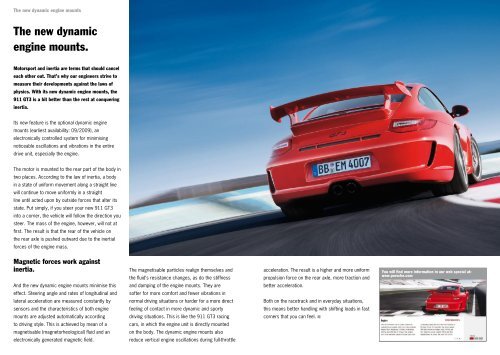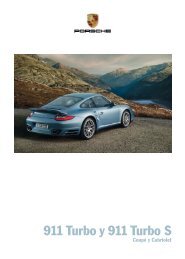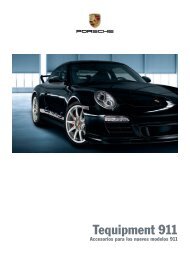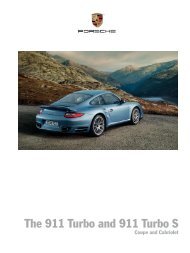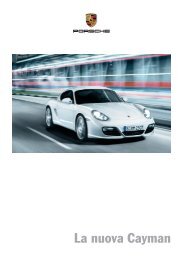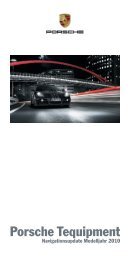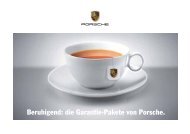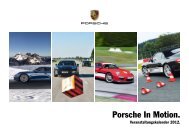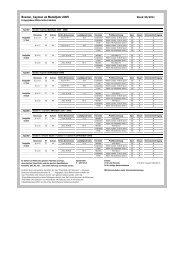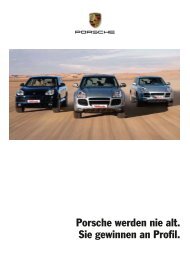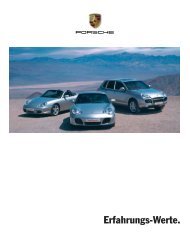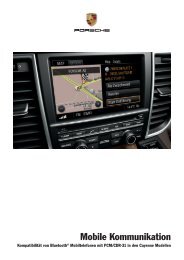Porschenews 01/2009 Go your own way. The new Cayman.
Porschenews 01/2009 Go your own way. The new Cayman.
Porschenews 01/2009 Go your own way. The new Cayman.
Create successful ePaper yourself
Turn your PDF publications into a flip-book with our unique Google optimized e-Paper software.
<strong>The</strong> <strong>new</strong> dynamic engine mounts<br />
<strong>The</strong> <strong>new</strong> dynamic<br />
engine mounts.<br />
Motorsport and inertia are terms that should cancel<br />
each other out. That’s why our engineers strive to<br />
measure their developments against the laws of<br />
physics. With its <strong>new</strong> dynamic engine mounts, the<br />
911 GT3 is a bit better than the rest at conquering<br />
inertia.<br />
Its <strong>new</strong> feature is the optional dynamic engine<br />
mounts (earliest availability: 09/<strong>2009</strong>), an<br />
electronically controlled system for minimising<br />
noticeable oscillations and vibrations in the entire<br />
drive unit, especially the engine.<br />
<strong>The</strong> motor is mounted to the rear part of the body in<br />
two places. According to the law of inertia, a body<br />
in a state of uniform movement along a straight line<br />
will continue to move uniformly in a straight<br />
line until acted upon by outside forces that alter its<br />
state. Put simply, if you steer <strong>your</strong> <strong>new</strong> 911 GT3<br />
into a corner, the vehicle will follow the direction you<br />
steer. <strong>The</strong> mass of the engine, however, will not at<br />
first. <strong>The</strong> result is that the rear of the vehicle on<br />
the rear axle is pushed outward due to the inertial<br />
forces of the engine mass.<br />
Magnetic forces work against<br />
inertia.<br />
And the <strong>new</strong> dynamic engine mounts minimise this<br />
effect. Steering angle and rates of longitudinal and<br />
lateral acceleration are measured constantly by<br />
sensors and the characteristics of both engine<br />
mounts are adjusted automatically according<br />
to driving style. This is achieved by mean of a<br />
magnetisable (magnetorheological) fluid and an<br />
electronically generated magnetic field.<br />
<strong>The</strong> magnetisable particles realign themselves and<br />
the fluid’s resistance changes, as do the stiffness<br />
and damping of the engine mounts. <strong>The</strong>y are<br />
softer for more comfort and fewer vibrations in<br />
normal driving situations or harder for a more direct<br />
feeling of contact in more dynamic and sporty<br />
driving situations. This is like the 911 GT3 racing<br />
cars, in which the engine unit is directly mounted<br />
on the body. <strong>The</strong> dynamic engine mounts also<br />
reduce vertical engine oscillations during full-throttle<br />
acceleration. <strong>The</strong> result is a higher and more uniform<br />
propulsion force on the rear axle, more traction and<br />
better acceleration.<br />
Both on the racetrack and in everyday situations,<br />
this means better handling with shifting loads in fast<br />
corners that you can feel. n<br />
You will find more information in our web special at:<br />
www.porsche.com


